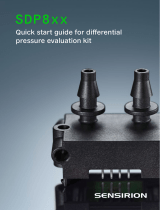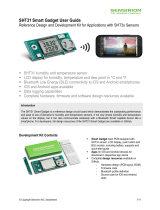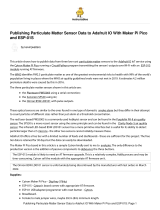Abstract
Sensirion SHTxx are relative humidity and temperature sensors of high quality. For taking advantage of their outstanding
performance some precautions must be taken during storage, assembly and packaging. Therefore, please read the
following instructions carefully - preferably during design-in phase and before production release of the respective
device. Special attention is required regarding the exposure to volatile organic compounds, i.e., high concentration and
long exposure time to respective gases shall be avoided. Such conditions are known to occur in manufacturing
environment and/or during storage. Therefore, proper handling and choice of materials are crucial. Applying sensors in
the field in ambient environment is not critical.
Applicability
This document is applicable to all Sensirion SHTxx
humidity and temperature sensors.
ESD protection
The sensor shall be protected from ESD (Electrostatic
Discharge) and only be handled in ESD protected areas
(EPA) under protected and controlled conditions (ground
all personnel with wrist-straps, ground all non-insulating
and conductive objects, exclude insulating materials
from the EPA, operate only in grounded conductive floor,
etc.). Protect sensor outside the EPA using ESD
protective packaging.
Protection against ESD is mandatory.
Exposure to chemicals
Humidity and Temperature sensors are highly accurate
environmental sensors and as such they are not ordinary
electronic components. The opening in the package
exposes the sensor to the environment and makes it
susceptible to pollutants. While applying sensors in the
field in ambient environment is not critical, pollutants are
known to occur in manufacturing environments and
during storage. Please carefully follow the guidelines in
this application note to ensure that you can benefit of the
sensor’s outstanding performance.
The sensor shall not get in close contact with volatile
chemicals such as solvents or other organic compounds.
Especially high concentration and long exposure must
be avoided. Ketenes, Acetone, Ethanol, Isopropyl
Alcohol, Toluene, etc. are known to cause drift of the
humidity reading – irreversibly in most of the cases.
Please note that such chemicals are integral part of
epoxies, glues, adhesives, etc. and outgas during baking
and curing. These chemicals are also added as
plasticisers into plastics, used for packaging materials,
and do out-gas for some period.
Acids and bases may affect the sensor irreversibly and
shall be avoided: HCl, H2SO4, HNO3, NH3 etc. Also
Ozone in high concentration or H2O2 have the same
effect and therefore shall be avoided. Please note, that
above examples represent no complete list of harmful
substances.
The sensor shall not get in contact with cleaning agents
(e.g., PCB board wash after soldering) or strong air
blasts from an air-pistol (not oil-free air). Applying
cleaning agents to the sensor may lead to drift of the
reading or complete breakdown of the sensor.
Ensure good ventilation (fresh air supply) to avoid high
concentrations of volatile chemicals (solvents, e.g.,
ethanol, isopropanol, methanol, acetone, cleaning
solutions, detergents…).
Packaging and storage
Prior to assembly or use of the sensors it is strongly
recommended to store the sensors in the original sealed
ESD bag at following conditions: Temperature shall be in
the range of 10°C – 50°C (0 – 125°C for limited time)
and humidity at 20 – 60%RH (sensors that are not stored
in ESD bags).


















